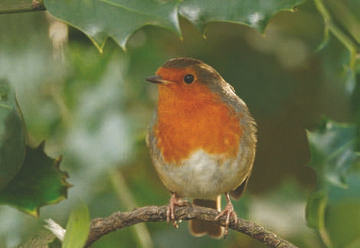
Robin © Steve Round
There is little difference between the Robin’s breeding and wintering distribution, although the winter map shows that they were missing from the two easternmost tetrads. Many birds do move from their breeding areas, however, as shown by one ringed at a feeding station at Linmere, Delamere on 16 January 2003 that was found in Nottinghamshire on 6 April 2003, 99 km away. Male and female Robins set up separate winter territories, often starting in autumn as soon as they finish moult, with males usually maintaining their breeding territory and females moving away, perhaps up to 5 km (Mead 1984). Unusually, both sexes sing to establish winter territories, using a different song from the breeding season. Birds with territories near street-lights often sing at night.
Robins can be very aggressive in establishment and defence of their winter areas, and the Christmas card picture of many birds together is not often seen. Most of the submitted counts were of one or two, with just 19 records of ten or more birds. Around well-provisioned feeding areas they seem to call a truce, especially in hard weather.
The presence of abundant cover within 2 m of the ground is an important feature of most occupied sites (BTO Winter Atlas) and the Atlas records showed that the main change in winter habitat from the breeding season is a reduction in the proportion of woodland records, with far more reported from hedges. There is a noticeable switch from preferring tall hedges in the breeding season (58% of the breeding season hedgerow records) to short hedges in winter (55% of the winter hedgerow records). They often use a low twig in a hedge as a perch from which to scan the ground and drop onto a spider or beetle. Robins try to find invertebrates on the ground throughout winter, often closely following gardeners to do so, and they also eat soft fruit, seeds, bread and fat. Vegetable food, however, rarely accounts for more than 10% of energy intake, showing the importance of live food and their susceptibility to periods when the ground is hard frozen or covered in snow (BTO Winter Atlas).
After the year-end, many males relax their winter territoriality and sing to attract a mate, and, especially in mild weather, some start building nests towards the end of our defined winter period, although they often leave them for several weeks before laying.
Sponsored by Robin Hart

